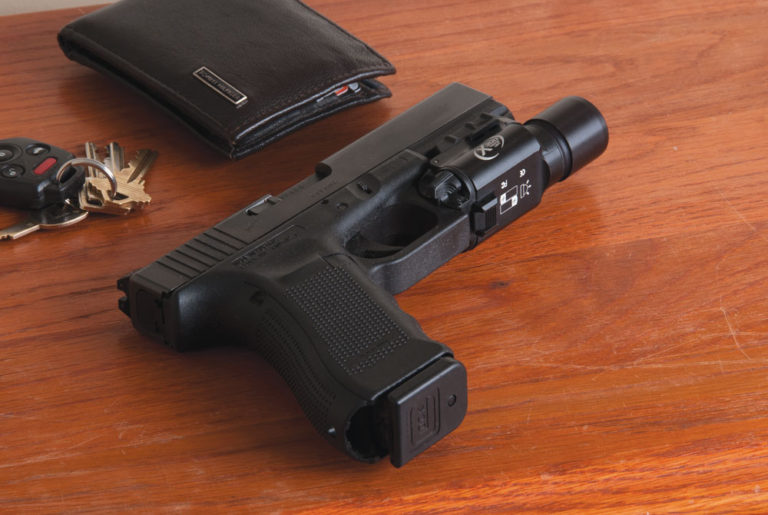
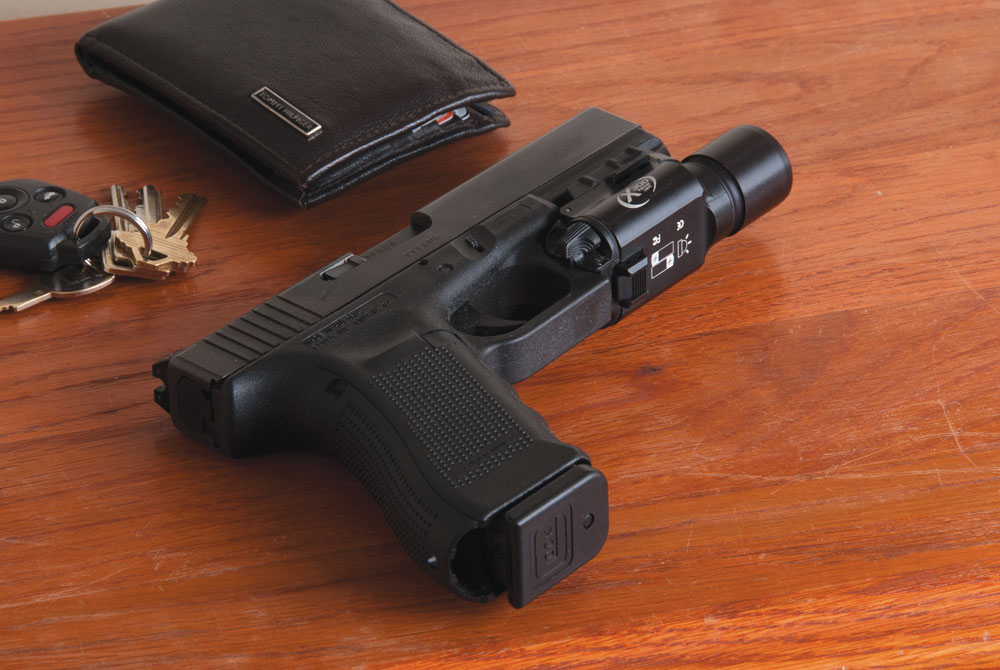
The author explains his thought process in choosing the best nightstand guns for home defense. In Part 1, he reaches for semi-auto pistols.
Glock G19 and G17
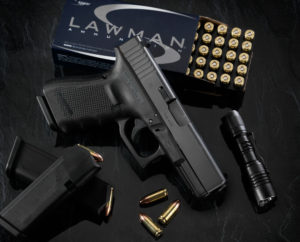
Many are the handgun models that have stood night guard beside my bed, but the one currently drafted into service is a Gen 4 Glock G17.
Why that one? Because it’s easy for me to shoot rapidly and accurately, because it holds 17 rounds in its magazine, and because my Surefire X300 light fits it beautifully. Among other reasons.
My preference is the 9mm G17, with a 17-round capacity, closely followed by the G19, with a 15-round capacity and a slightly shorter frame. I don’t get warm fuzzies over the .40 S&W cartridge; personally, I consider it less than a .45 in power and less than a 9mm in capacity—thus, a hybrid that attempts to fill the function of both yet fails to match either. However, it is a good cartridge, and for admirers of the .40 S&W, the G22 is really hard to beat.
I don’t recommend messing around much modifying a Glock. The reason they have such a stellar reputation for reliability is that the factory design and parts work, and work every time. The only two mods that I occasionally suggest are to fit a Ghost aftermarket trigger with a lighter pull and an overtravel stop and to replace the plastic factory sights with metal ones, preferably night sights with tritium inserts.
Finally, Glocks are a very good value when you go to exchange your hard-earned dollars for a personal protection tool. Standard models, new, bring around $550 to $580; guns in good used condition can be had for around $400.
Smith & Wesson M&P
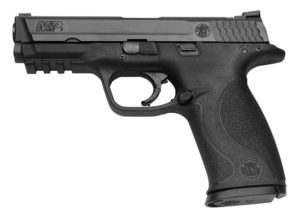
The full-size M&P (Military & Police) semi-auto is arguably the most ergonomic polymer-framed pistol ever designed.
That’s a pretty lofty statement, but it’s well founded. M&Ps are extraordinarily comfortable in the hand, and they come with three different-size grip inserts to finesse the grip size until it is just perfect for the owner’s hand. The grip angle is the result of intensive research on the natural angle of the human fist in relation to the arm, resulting in a pistol that points itself as naturally as granny’s naughty-finger when you’re caught with your hand in the cookie jar. The grip itself is very high in relation to the axis of the bore, minimizing muzzle jump and enabling the shooter to control recoil well.
In addition to being engineered for absolute reliability under the most adverse conditions imaginable, Smith & Wesson’s M&P semi-autos have two unusual features. First, the fire controls are ambidextrous (dual slide-catches, magazine release button is reversable), making this one of the best possible choices for left-hand shooters. That feature can save a right-hand shooter’s bacon, too, should their shooting hand be injured, or occupied fending off an attacker. The second feature is the fact that M&P semi-autos can be purchased with or without a thumb safety, which—if present—is located in a classic 1911-esque position.
Many versions exist in 9mm, .40 S&W, and .45 ACP, offering various sights, barrel lengths, colors and so on, and all of them have a light rail on the dust cover in front of the trigger guard. Speaking specifically of the full-size models, you can’t go wrong with any of the variations. Prices are comparable to Glocks; new M&Ps can be had for $560 to $700, depending on bells and whistles, and good used versions can be purchased for around $400.
Springfield XDm

A refinement of the very popular XD pistol, the “M” version is sleeker and perhaps a bit lighter, depending on variation. I like how it looks better, too. Made in Croatia, these semi-autos have gained a huge following courtesy of good prices and solid performance. Personally, as with most polymer, double-stack pistol designs, I much prefer the full-size models to the compact and subcompact models.
All XDs have trigger-shoe-type safeties, which prevent the pistol from firing unless the trigger is pressed rearward. Additionally—and my favorite feature of the XD series—they have a 1911-type grip safety. In essence, the gun can’t fire until it is firmly grasped by the shooter’s hand. Theoretically, this means that the shooter has control of the firearm before it can fire.
The only technical nitpick I can make is that the axis of the bore is—as polymer pistols go—somewhat high above the grip, making for a design with more muzzle jump than others.
While I like the 9mm (with it’s outstanding 19-plus-1 capacity) and .40 S&W versions, I particularly like the .45 ACP version with it’s 13-plus-1 capacity. It’s one of the better-feeling high-capacity .45s I’ve fired. Price runs around $550, depending on accessories.
Ruger SR9 & SR40

Retailing at $529, with a street price of under $500, the Ruger SR9 is probably the least-expensive polymer-frame pistol that—in my opinion—really makes the “depend your life on it” grade.
Technically, it’s a striker-fired pistol engineered for reliability and good recoil control. The axis of the bore is low against the hand, helping maximize muzzle control during rapid fire.
Containing 17-plus-1 cartridges, it offers ergonomic concessions such as a reversible backstrap and ambidextrous safety and magazine release. Endurance tests by abusive gunwriters have proved it robust and capable. While it’s available in .40 S&W and .45 ACP, my preference is 9mm.
SIG Sauer P226 & P229
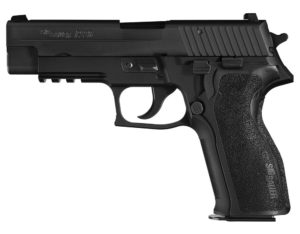
This handgun takes us from the realm of polymer frame pistols to that of metal frames. In my opinion, no polymer-framed handgun ever has or ever will balance as well as a good metal-framed model, and SIG’s P226 is one of the most ergonomic of them all. Its sibling model, the P229, has a slightly shorter barrel, but it is an excellent pistol too.
Of double/single action design, these SIG pistols employ a decocker for safe carry. Translation: When a cartridge is chambered by working the slide, the external hammer is left cocked; pulling down on a lever on the left of the slide, about where a typical manual thumb safety would be located, drops the hammer without firing the cartridge. If the pistol should be needed in a hurry, a long, heavy double-action (both cocks and then fires—thus “double” action) trigger pull will cock the hammer and fire the pistol. Every shot thereafter will be single-action, since the slide leaves the hammer cocked after kicking out the spent cartridge case and chambering a fresh round. If the shooter ceases shooting before the magazine is empty, pulling on the decocker will lower the hammer to the safe position again.
I can’t stress enough what a quality pistol SIG builds, as long as you stay with the metal-framed versions. I’m not partial to the company’s polymer-frame guns. This isn't to say that they’re bad, it’s just that the metal-frame guns are so good.
Capacity is 15-plus-1 rounds for the P226, 13-plus-1 for the P229, and price starts just under $1,000. That said, street price is usually considerably lower. Optional night sights are available, and highly recommended.
SIG Sauer P220
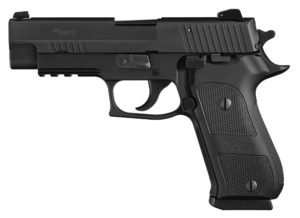
Imagine a big brother to the SIG P226 with a single-stack magazine in .45 ACP, and you’ve got the P220. Of very ergonomic, shootable design, and carrying 8-plus-1 cartridges, the P220 is in my opinion second only to the classic 1911 in .45-caliber pistol design; indeed, it offers a couple of features that many shooters prefer, such as the decocker, easier disassembly, and so on.
It’s a full-size fighting pistol. In other words, unless you’ve the stature of an NFL player, don’t bother attempting to stash it away out of sight on your person. Price starts around $993 and runs up from there depending on options.
Model 1911 (various makes)
Without a doubt the most popular, legendary semi-auto of all time, the 1911 is also the longest-lived.
Why is it so well loved? In short, it’s incredibly ergonomic, is easy to manipulate while under stress, and is very robust and reliable. 1911 handguns made in recent decades tend to be very accurate, too.
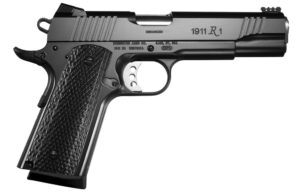
Many sizes of the 1911 exist, from little 3-inch-barreled compact models up to 6-inch long-slide versions, in calibers from .22 Long Rifle to .45 ACP and even bigger. For personal protection purposes, my recommendation is to stick with a full-size, steel-frame model in .45 ACP. It’s what Browning designed, and it’s the most balanced of the lot in mechanical function.
Alloy-frame models are popular among folks intending to carry a 1911 concealed, and they make a good option, as do “Commander” versions, with a 4-inch barrel. My favorite 1911 carry gun is just that, an alloy-framed Commander with a rounded butt, in .45 ACP. However, for a proper nightstand or full-on disaster-handling gun, the full-size, steel-framed versions tame recoil better and offer the utmost in reliability.
Most experts agree that not only is the .45 ACP the most reliable cartridge in the 1911, it makes the most sense. If you’re set on shooting a 9mm or .40 S&W, get something with a double-stack magazine. (There are adaptations of the 1911 that accept double-stack magazines—some of them very good—but at its best, the 1911 is a single-stack design.)
One perceived drawback for a dedicated nightstand gun is the lack of a light-mounting rail on most 1911s. If it concerns you, get one with a rail—they are available from most major manufacturers. Otherwise, just learn to pair it with a good hand-held tactical flashlight, which is what I do.
Part 2 covers top revolver choices for the nightstand.

Next Step: Get your FREE Printable Target Pack
Enhance your shooting precision with our 62 MOA Targets, perfect for rifles and handguns. Crafted in collaboration with Storm Tactical for accuracy and versatility.
Subscribe to the Gun Digest email newsletter and get your downloadable target pack sent straight to your inbox. Stay updated with the latest firearms info in the industry.









My Glock 19 Gen 4 was a nightmare for reliability. It would mis-fire one in 30 or 40. I sent it back to the manufacturer, it came back better but no where near as good as my Sig p229 elite… actually, the VERY best gun I’d bet my life on is the Czech CZ 75BDS 9mm. The CZ has NEVER failed to load or fire… NEVER. That or a revolver is all I’d trust. I don’t get all the Glock fanboys, the platform with all the plastic and the metal clips is just not as high a quality as an all steel gun… I don’t get it.
A very well written article. There isn’t a single gun on this list that I wouldn’t use with absolute confidence.
My EDC is a Glock 21 or an XD 45. I love the XD’s grip safety, and both it and the Glock are absolutely reliable. The main reason my number one EDC is my Glock is simply that I shoot better with it.
But, I would like to add one alternative here. While the M&P is an ergonomic dream, I have to say the the one gun that fit my hand perfectly from the very first time I ever picked it up is the Walther PPX. The first time my wife and I held one at a gun show was the decision point, and a nice PPX went home with us that very day. The first trip to the range was no disappointment. Accurate? Oh hell yeah! Reliable? No malfunctions with cheap Russian target ammo. Ours resides on my night stand with a mounted light ready to rock-n-roll. She is married to her Beretta, and she’s darn good with it.
So, when you are checking out guns, please try a PPX and make your own determination. To me . . it fits like it was made for me.
Cz-75 is every bit as good as the Sigs, and a lot less expensive.
This is absolutely TRUE!!!! I have a Sig 228 made in Germany. I love it. I also have two CZs; one is a compact, the other full-size. I would be just as happy shooting or competing with a CZ as I would with a Sig. Don’t forget, the ergonomics of most guns today copied at least the idea of the CZ.
I love my CZ, best hand gun I’ve ever owned. Most reliable… Beats all my American makes, thats just a fact.
Everything listed is a very well rounded defense pistol. However consider that the 1911 is a single action and most now have light trigger pulls (and some have VERY light triggers). Not the best idea for a bedside gun when you are woken up from a dead sleep and have seconds to analyze what is going on. I have personally seen several examples of unintentional / negligent / accidental (whatever you chose to call them) discharges in those exact circumstances.
In that instance a traditional double action pistol or striker fired pistol with a moderate weight trigger is the preferred option.
I agree, and I have spent a lot of time with a 1911, but I am a deep sleeper and waking me up is a chore. I need something at the ready–probably a revolver, to be honest, as does my wife who is a very light sleeeper. Of course, a person could keep a loaded semi-auto, but it should be double action.
I’d be careful with those “cocked & locked” guns like the 1911. I just SO’d a major match and you’d be surprised how many competitors forgot to thumb the safety off when they picked up the 1911’s to fire.
They were to used to drawing from a holster to fire.
With revolvers you just pull the trigger.
Take a long look at the Beretta PX4 Compact. In the nightstand drawer, loaded magazine is in the gun, the safety is off, there is a round in the chamber, you can see the hammer is not cocked [decocked]. To use, you would fire the first round double action, the remaining rounds are fired single action semi-auto style.
Don’t know how you could be much safer with an semi-auto.
Thanks, I will.